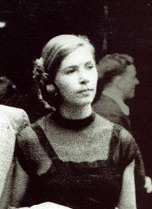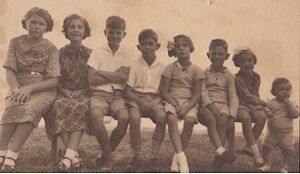Mimi Parent facts for kids
Quick facts for kids
Mimi Parent
|
|
|---|---|

Parent c. 1948
|
|
| Born |
Marie Parent
September 8, 1924 Montreal, Canada
|
| Died | June 14, 2005 (aged 80) Villars-sur-Ollon, Switzerland
|
| Occupation | Artist |
| Spouse(s) |
Jean Benoît
(m. 1948) |
| Parent(s) |
|
Mimi Parent (born Marie Parent; September 8, 1924 – June 14, 2005) was a Canadian Surrealist artist. She was known for her unique art style. For many years, she lived and worked in Paris, France. Her art often used symbols and everyday objects in new, imaginative ways. She even used human hair in some of her pieces.
Contents
Early life and education
Marie Parent was born in Montreal, Canada, on September 8, 1924. She was one of nine children of the famous architect Lucien Parent. From 1942 to 1947, she studied art at the École des Beaux-Arts de Montréal. There, she met Jean Benoît, who would later become her husband.
Mimi studied under an artist named Alfred Pellan, who greatly influenced her work. She was known for being a student who liked to challenge rules. She was later asked to leave the school. This happened after she joined a group of artists called Prisme d’yeux, which had some new and different ideas.
Artistic career
In Canada, Mimi Parent was interested in Surrealism and automatism, which are art styles that explore dreams and the unconscious mind. In 1959, she became a member of the Paris Surrealist Group. She worked with other famous Surrealist artists like André Breton and Marcel Duchamp.
Mimi Parent was especially known for her 3D "tableaux boxes." These were like small scenes or dioramas. In these boxes, she would place figures and objects related to old stories, myths, and her own imagination. She often included symbols of the moon and sun, which represented male and female energies. Mimi also used unusual materials, like human hair, in her art. One famous piece, Maitresse (1996), was a whip made from two braids of her own hair.
Exhibitions and recognition
In 1947, Mimi Parent had her first solo art show in Montreal. It was at the Dominion Gallery and received good reviews from Time magazine.
In 1948, she received the Cézanne medal for her art. That same year, she married Jean Benoît, and they moved to Paris. They became important figures in the Parisian Surrealist group, led by Andre Breton.
Mimi Parent took part in many important art shows. In 1960, she exhibited at the "Surrealist intrusion into the Enchanter's Domain" in New York. In 1966, she had a solo exhibition at the "Maya" gallery in Brussels. She also showed her art in cities like Chicago, London, Lausanne, and Frankfurt.
She helped organize a big Surrealist exhibition in Paris called "Exposition inteRnatiOnale du Surréalisme" (EROS) in 1959-1960. While Marcel Duchamp is often given credit, Mimi Parent came up with the idea for the exhibit's special catalogue. It was called Boite Alerte – Missives Lascives and looked like a green box where ideas could be "posted."
Later years and legacy
Mimi Parent continued to live and create art in Paris, France, for many years. After Andre Breton passed away and the Paris Surrealist Group ended, Parent started making what she called "picture objects." These were a mix of sculptures made from found objects and paintings. Later, she focused on ink drawings.
She had many solo exhibitions throughout her life, including shows in Paris (1984), Bochum (1984), and Noyers-sur-Serein (1992). She was an active artist until the end of her life. Some of her most notable shows included Femininmasculin at the Centre Georges Pompidou in Paris (1995), La femme Et Le Surrealisme in Lausanne (1987), and Surrealism: Desire Unbound at the Tate Modern in London (2001).
In 2004, the Musée national des beaux-arts du Québec held a special exhibition featuring both Mimi Parent and Jean Benoît. Mimi Parent passed away on June 14, 2005, in Switzerland. Her ashes were scattered by her husband at Château de Lacoste, a historic estate in France.
See also
 In Spanish: Mimi Parent para niños
In Spanish: Mimi Parent para niños


